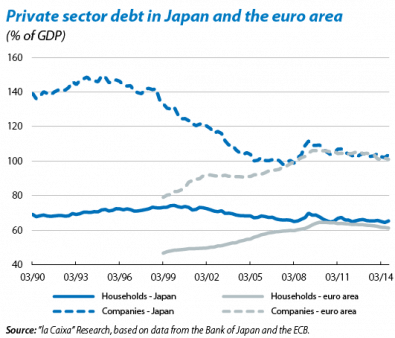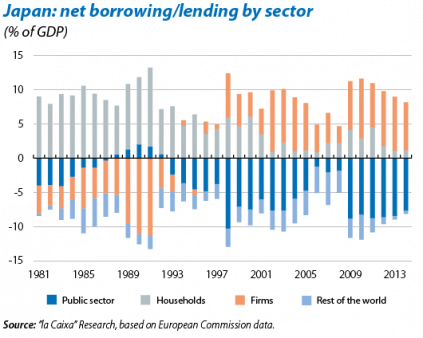An accommodative monetary environment: the new norm for the private sector
The main developed economies have found themselves in an incredibly accommodative monetary environment after more than six years of very low interest rates and the implementation of a wide range of unconventional monetary tools. The ultimate aim of such monetary expansion is to encourage economic activity after the crisis suffered in 2008. Specifically, in the euro area, where the recovery is slow and inflation worryingly low, in March the monetary authority embarked on a large-scale asset purchase programme. This new monetary stimulus has confirmed that interest rates will remain very low for a prolonged period of time, highlighting the need to understand the effects this incredibly accommodative monetary environment may have on economic agents in the private sector (households and firms), which play a key role in guaranteeing the effectiveness of monetary policies designed to generate economic growth by stimulating aggregate demand. To carry out this analysis, we have analysed the behaviour of households and companies in Japan as they have been living with a monetary environment similar to the one in the euro area for more than 15 years.
Let us start with Japanese households. When the crisis erupted in 1990, their situation was not excessively critical as Japanese households tended to save (with a savings rate of around 20% of disposable income, 9 pps and 6 pps above that of the US and the euro area at the start of the 2008 crisis) and had moderate levels of debt, namely 69% of GDP. The reasons for this composition of household finances were not only cultural (words such as «austerity» and «frugality» are often related to Japanese culture) but also of a different nature, such as demographic and institutional factors which played an important role as well. Of note among the latter are the tax breaks for savings, an insufficient state pension system and the difficulty in households obtaining credit, forcing them to save for any large purchases or as a precaution against future shocks. Another factor boosting savings was the fact that, at that time, most of the population was fully mature, a stage in the life cycle when people tend to save more. On the other hand, the situation of households in the euro area when the crisis started in 2008 was considerably different from that of Japan, with moderate savings, high consumption and high levels of debt in the countries suffering most from the real estate bubble,1 such as Ireland (with a debt of more than 120% of GDP in 2009) and Spain (over 80% of GDP in 2010).
To combat the tough economic recession and deflation, the Bank of Japan implemented an incredibly accommodative monetary policy (see the article «Monetary and fiscal tribulations: the long road towards Abenomics» in this Dossier), cutting official interest rates to minimum levels and keeping them there for more than 15 years. This environment should have stimulated aggregate demand; however, this was not the case as far as households were concerned. Although the savings rate fell by more than half after 20 years, this was not due to higher consumption but because growth in gross disposable income had halted and the population had aged considerably (old age is the stage in the life cycle when savings tend to be used up). Between 1995 and 2014 household consumption stalled, on average growing by a meagre 0.2% year-on-year (compared with 4.5% in the US and the 2.8% in the euro area). Some of the reasons why rock bottom interest rates did not stimulate demand are that real interest rates fell less sharply due to the fact that the inflation rate remained negative and, as some authors have argued,2 the monetary transmission mechanism through households was weak. Specifically, the theory of intertemporal consumption suggests circumstances in which cuts in real interest rates can increase savings and reduce consumption, the opposite of what happens, in general, in most economies. This would be the case for agents with large amounts of assets in relation to their income and a limited willingness to exchange consumption over time, who therefore tend towards more stable consumption throughout their lives. A fall in real interest rates in the short term would reduce the return on savings and lead to lower future consumption. And this would encourage agents to offset these lower returns by increasing their current savings to maintain similar levels of consumption in the future.
In short, the behaviour of Japanese households in terms of their savings has changed radically since the start of the crisis. If households are saving less and the government is borrowing more and more, another agent must have increased its savings capacity. This is due to the fact that one sector of the economy cannot borrow if another does not lend, whether it is another agent in the domestic economy or the rest of the world (in this last case, net borrowing from the rest of the world has remained at moderate levels over time). Consequently, the fall in household savings and the increase in government debt have been offset by the appearance of a new saver, the corporate sector. Several factors explain the fact that, in Japan's accommodative monetary environment of the last 15 years, aggregate demand has not been stimulated by larger investment on the part of the private sector. The first would be due to the considerable over-investment of companies when the crisis erupted, and to their low profitability.3 The second factor would be based on the need for deleveraging as the real estate and financial bubble resulted in companies with huge levels of debt (140% of GDP in 1990). After the price of these assets slumped, they were forced to sort out their balance sheets and deleverage via a strategy of contained expenditure and retained earnings. Once this deleveraging was under control, companies continued with their strategy of retaining profits given the uncertain environment regarding the economic cycle, depressed aggregate demand, a taxation system that encouraged this strategy and, finally, the lack of attractive alternatives to invest their liquidity. All these elements brought about a sharp rise in corporate savings. In the case of the euro area, deleveraging is more moderate as the levels of debt reached were much lower than in Japan (the peak was 106% of GDP in 2009) and companies in the euro area do not seem to be as willing to save as their counterparts in Japan.
By way of conclusion, there are few similarities between the Japanese economy and the euro area regarding the private sector balance sheet and its behaviour. For households, the weakness in the monetary transmission mechanism to the Japanese economy is unlikely to be applicable to continental Europe given the different fundamentals between these two regions. In fact, there has been significant growth in private consumption in most European countries while the financial position of European firms is also more solid in general, helping investment to recover.
Ariadna Vidal Martínez
Macroeconomics Unit, Strategic Planning and Research Department, CaixaBank
1. In the case of Japan, the real estate bubble in 1990 did not start with households but with companies investing heavily in such assets.
2. Muellbauer, J. and Murata, K. (2009), «Consumption, land prices and the monetary transmission mechanism in Japan», CEPR.
3. This is due to excess capital which means the rate of return on capital is low.





